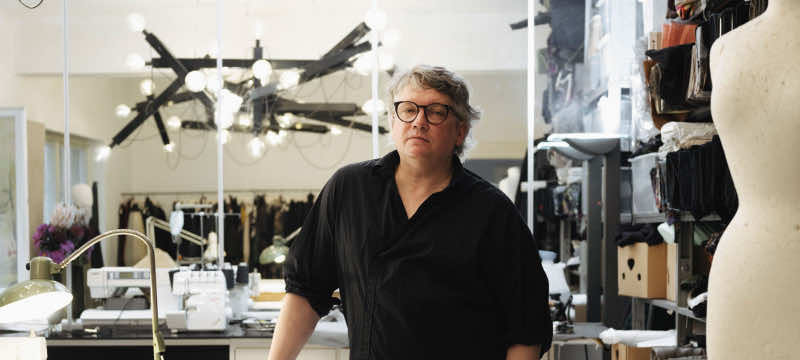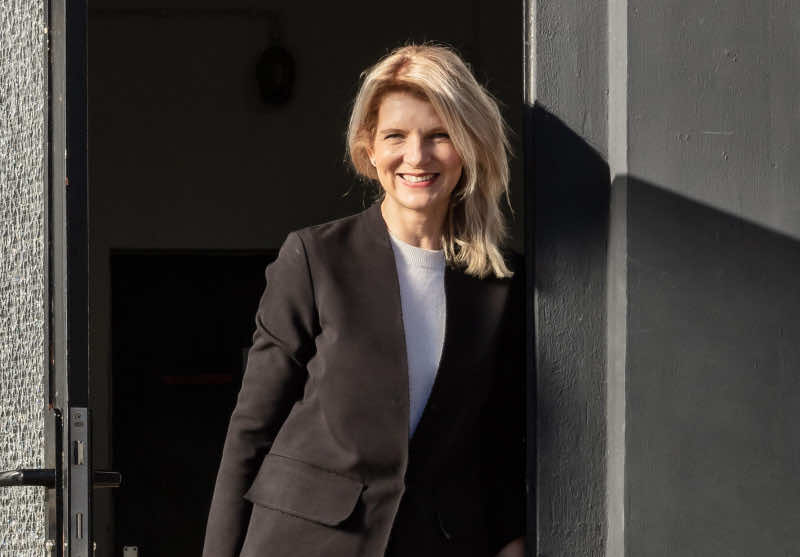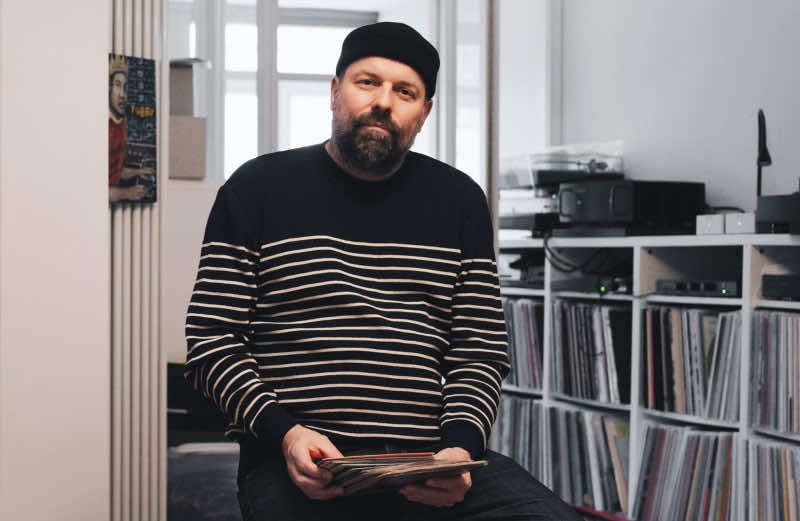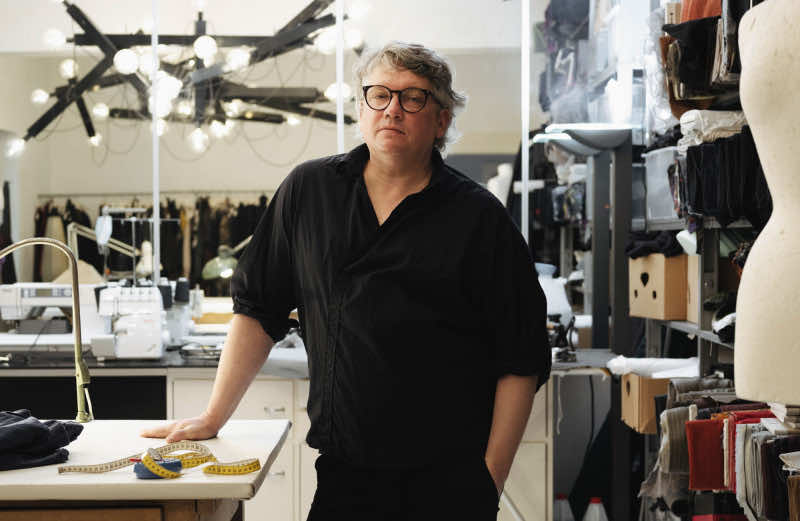
Fabric artist
André Martino Schreiber
Nuremberg-based designer and fabric artist André Martino Schreiber plays with natural materials and is therefore the perfect person to design signature clothing for Retterspitz. After all, our employees should convey the idea of wellbeing with their clothing while also feeling as comfortable as possible while wearing it. Schreiber took inspiration from an unexpected source – a relic from the working days of yore.
In the past, workmen wore blue overalls. And not the modern kind made from polyester – the originals. “For decades, blue overalls were the classic workman’s uniform across Europe. And they had wonderful properties,” explains Schreiber. “Slightly elastic, comfortable against the skin and even climate-regulating, because they warm the wearer when it’s cold and cool them when it’s warm. Unfortunately, this special material stopped being produced almost 20 years ago,”
Although in the past this herringbone twill was produced by numerous weaving mills, this fabric – like the original blue overalls – has since disappeared from the market.
Tracking down remaining fabric
Over the past few years, André Schreiber has found remnants of old overalls – on holiday, at flea markets and on the internet. When Retterspitz approached Schreiber to create clothing for the flagship store, it was immediately clear to him that it had to be made of this very herringbone twill, because as a naturally pure fabric it perfectly complements Retterspitz’s natural products.
“As a raw material it is an untreated fabric, generally light beige in colour, that can be dyed in any colour you like. For me, this fabric is like a canvas that opens up a multitude of design possibilities.”
Sample collection of raw materials
After searching long and hard, André Schreiber found 500 metres of the fabric left over in a regional weaving mill, which then made its way to his studio on Kaulbachstraße. Schreiber put together a sample collection of skirts, trousers, tops and jackets that will now be customised for all of the employees working in the Retterspitz flagship store. Tailored to suit the employees’ needs, the uniform will actually be a kind of multiform – with the material as the common element.
“The fabric will initially be left in a typical off-white,” explains André Schreiber, “this way we can start with our first collection and open it up to experiments. Perhaps we might dye the next pieces using a decoction of walnut leaves. The raw material is like a blank sheet of paper on which we can experiment with natural media and plant-based dyes in the spirit of Retterspitz.”
Behind the scenes
Further persons

Katja Reiter, Interior designer
Interior designer Katja Reiter has already completed much-noticed projects in Nuremberg. Here, her latest task was to create a place that makes visitors feel like they are stepping into a separate world in the middle of the city. Together with Retterspitz owner and Managing Director Markus Valet, she found inspiration in the style and shopping capital of Europe, Milan, gathered impressions for the interior design and, in her search for something special, found what she was looking for in the Franconian Jura. Just as it should be: after all, Retterspitz not only stands for healing, caring and wellbeing, but also regionality. Learn more

Andreas Amtmann, Brand strategist
From the very beginning, the project was supported by strategists from FYFF, an agency based in Nuremberg, to ensure that the impression given by the first Retterspitz flagship store goes hand in hand with the philosophy and design of the Retterspitz brand. Learn more

Flo Seyberth, DJ & composer
He is known as part of the musical duo Boozoo Bajou and from songs such as Night over Manaus, which was used in a Martini advert featuring George Clooney. Flo Seyberth is from Nuremberg, and it was up to Retterspitz to engage the Franconian DJ and composer to create a bespoke compilation for the flagship store. Learn more
Früher trugen Handwerker einen „Blaumann“. Und zwar nicht die neumodische, von Polyester durchsetzte Variante – sondern das Original. „Der Blaumann war über Jahrzehnte hinweg die klassische europäische Handwerksbekleidung, typisch waren Jacken-Hosen-Kombinationen oder Overalls. Und das mit wunderbaren Trageeigenschaften“, so Schreiber. „Leicht elastisch, angenehm auf der Haut und sogar klimatisierend, weil er im Kühlen wärmt und in der Wärme kühlt. Leider wird dieser spezielle Stoff so schon seit bald 20 Jahren nicht mehr hergestellt.“
Wurde dieser Fischgratköper früher von vielen Webereien hergestellt, so ist der Stoff in den vergangenen Jahren, gemeinsam mit dem originalen „Blaumann“, vom Markt verschwunden.
Aufspüren von Restbeständen
In den vergangenen Jahren hat André Schreiber immer wieder Restbestände alter Blaumänner gefunden – in Urlauben, auf Flohmärkten und im Internet. Als Retterspitz mit dem Wunsch auf ihn zukam, die Bekleidung für den Flagship-Store zu kreieren, war für André Schreiber augenblicklich klar, dass es ebendieser Fischgratköper sein sollte, da dieser als natürlich reiner Stoff perfekt zu den Retterspitz Naturprodukten passt.
„Als Rohware ist es ein unbehandelter Stoff, zumeist in einem hellbeigen Ton, den man in alle Richtungen einfärben kann. Für mich ist dieser Stoff wie eine Leinwand, die eine Vielzahl gestalterischer Möglichkeiten eröffnet.“
Musterkollektion aus Rohware
Nach langer Suche fand André Schreiber in einer regionalen Weberei einen Restbestand von 500 Metern des Stoffes, die dann den Weg in sein Atelier in der Kaulbachstraße gefunden haben. Es wurde eine Musterkollektion aus Röcken und Hosen, Oberteilen und Jacken geschaffen, welche nun für alle Mitarbeiter*innen des Retterspitz Flagship-Stores einzeln individualisiert wird. Abgestimmt auf die Bedürfnisse, wird aus der Uniform eine Art Multiform – mit dem Material als verbindendes Element.
„Der Stoff soll zunächst in seinem typischen, gebrochenen Weiß belassen werden“, sagt André Schreiber, „so starten wir mit unserer Erstkollektion, um dann ein Versuchsfeld zu eröffnen. Vielleicht färben wir die nächsten Stücke zum Beispiel mit einem Sud aus Walnussblättern. Die Rohware ist wie ein Blatt weißes Papier, auf dem wir mit natürlichen Mitteln und pflanzlichen Farbstoffen ganz im Sinne von Retterspitz experimentieren können.“

